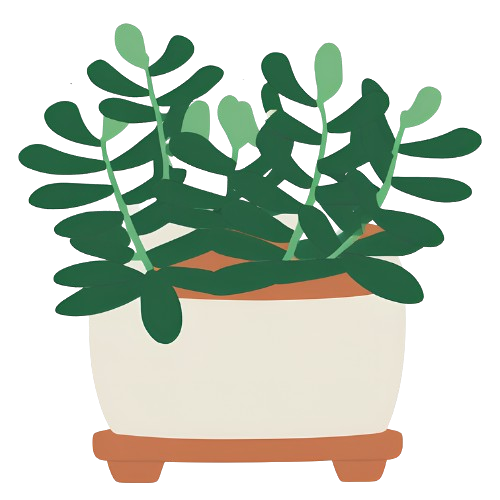Jade plants, also known as Crassula ovata, are popular succulent houseplants known for their thick, glossy, oval-shaped leaves and tree-like appearance. Native to South Africa and Mozambique, these plants are prized for their easy care and longevity, often becoming heirloom plants passed down through generations.
However, one common concern among jade plant owners is slow growth. This comprehensive guide will delve into the reasons behind the slow growth of jade plants, how to care for them, and tips to encourage healthy growth.
Table of Contents
Introduction to Jade Plants
Jade plants, often called the “money plant” or “friendship tree,” are beloved for their striking appearance and minimal care requirements.
They are considered symbols of good luck and prosperity in many cultures, making them popular gifts. These succulents can live for decades, growing slowly but steadily, eventually reaching heights of up to six feet when well-cared for.
The Natural Growth Rate of Jade Plants
Before addressing concerns about slow growth, it’s important to understand the natural growth rate of jade plants. These succulents are inherently slow growers, typically adding only a few inches in height each year.
This slow and steady growth is normal and should not be a cause for concern. However, if your jade plant seems to be growing even more slowly than expected, there could be several factors at play.
Common Reasons for Slow Growth in Jade Plants

Light Conditions
Light is one of the most critical factors influencing the growth rate of jade plants. These succulents thrive in bright, indirect sunlight. Insufficient light can lead to slow growth, leggy stems, and pale leaves. On the other hand, too much direct sunlight can cause sunburn, leading to brown or red-tinged leaves.
Solution: Place your jade plant in a location where it receives at least four to six hours of bright, indirect sunlight daily. East-facing windows are ideal, as they provide gentle morning sunlight. If natural light is insufficient, consider using grow lights to supplement.
Watering Practices
Improper watering is a common cause of slow growth in jade plants. Overwatering can lead to root rot, while underwatering can cause dehydration and stunted growth.
Solution: Water your jade plant thoroughly but infrequently. Allow the soil to dry out completely between waterings. A good rule of thumb is to water when the top inch of soil feels dry to the touch. Ensure the pot has drainage holes to prevent water from accumulating at the bottom.
Soil Quality
The type of soil used can significantly impact the health and growth rate of jade plants. Heavy, compacted soil can hinder root development and lead to poor drainage, causing root rot.
Solution: Use a well-draining succulent or cactus potting mix. You can also create your own mix by combining regular potting soil with perlite or sand to improve drainage.
Nutrient Deficiency
Jade plants require nutrients to grow, and a lack of essential minerals can result in slow growth and pale, yellowing leaves.
Solution: Fertilize your jade plant with a balanced, water-soluble fertilizer formulated for succulents. Apply the fertilizer once every three to four months during the growing season (spring and summer). Avoid over-fertilizing, as this can lead to nutrient burn.
Pot Size
The size of the pot can affect the growth rate of jade plants. A pot that is too small can restrict root growth, while a pot that is too large can retain excess moisture, leading to root rot.
Solution: Choose a pot that is slightly larger than the plant’s root ball. Repot your jade plant every two to three years or when you notice the roots becoming cramped.
Temperature and Humidity
Jade plants prefer moderate temperatures and low humidity. Extreme temperatures and high humidity levels can stress the plant and slow its growth.
Solution: Keep your jade plant in a room with temperatures between 65°F and 75°F (18°C to 24°C). Avoid placing it near drafty windows or heating vents. Maintain low humidity levels by using a dehumidifier if necessary.
Pests and Diseases
Pests such as mealybugs, spider mites, and scale insects can infest jade plants, causing damage and slowing growth. Fungal infections and root rot can also hinder growth.
Solution: Regularly inspect your jade plant for signs of pests and diseases. If you notice any issues, treat the plant with insecticidal soap or neem oil. Ensure proper watering practices to prevent fungal infections and root rot.
Detailed Care Guide for Jade Plants
Light Requirements
Jade plants need plenty of light to thrive. Ideally, they should receive at least four to six hours of bright, indirect sunlight each day. While they can tolerate some direct sunlight, too much can cause sunburn. If you don’t have a suitable spot with enough natural light, consider using a grow light to supplement.
Watering Schedule
Watering jade plants correctly is crucial for their health and growth. Overwatering is a common mistake that can lead to root rot, while underwatering can cause the plant to dry out and stop growing. The key is to allow the soil to dry out completely between waterings.
Steps for Proper Watering:
- Check the soil: Before watering, stick your finger into the soil up to the first knuckle. If the soil feels dry, it’s time to water.
- Water thoroughly: Water the plant until water drains out of the bottom of the pot. This ensures that the roots receive enough moisture.
- Allow to dry: Wait until the soil is completely dry before watering again. This can take anywhere from one to three weeks, depending on the season and humidity levels.
Soil and Potting Mix
Jade plants need a well-draining soil mix to prevent water from sitting around the roots. A succulent or cactus potting mix is ideal. If you prefer to make your own mix, combine regular potting soil with perlite or coarse sand to improve drainage.
Fertilization
While jade plants don’t require frequent fertilization, providing nutrients during the growing season can help encourage healthy growth. Use a balanced, water-soluble fertilizer formulated for succulents. Dilute the fertilizer to half-strength and apply it once every three to four months during spring and summer.
Pruning and Shaping
Pruning is not only beneficial for the appearance of your jade plant but also for its overall health and growth. Regular pruning can help maintain a compact shape and prevent the plant from becoming leggy.
Steps for Pruning:
- Use clean, sharp scissors or pruning shears to avoid introducing diseases.
- Remove dead or damaged leaves to improve the plant’s appearance and prevent disease spread.
- Trim back any leggy or overly long stems to encourage bushier growth.
- Make cuts just above a leaf node (the point where a leaf attaches to the stem) to promote new growth.
Repotting
Repotting jade plants every two to three years helps refresh the soil and provides more room for root growth. Choose a pot that is slightly larger than the current one, and ensure it has drainage holes.
Steps for Repotting:
- Gently remove the plant from its current pot, being careful not to damage the roots.
- Shake off any old soil and inspect the roots for signs of rot or damage.
- Place the plant in the new pot and fill in with fresh potting mix.
- Water the plant lightly and place it in a spot with bright, indirect light.
Tips to Encourage Faster Growth
While jade plants are naturally slow growers, there are several steps you can take to encourage faster growth and ensure they remain healthy and vibrant.
Optimize Light Conditions
Ensure your jade plant receives enough light by placing it in a bright location with plenty of indirect sunlight. If natural light is insufficient, use a grow light to supplement.
Maintain Proper Watering Practices
Follow the watering guidelines to avoid overwatering or underwatering your jade plant. Consistent watering practices help prevent stress and promote healthy growth.
Use the Right Soil
Plant your jade plant in a well-draining succulent or cactus potting mix. Avoid using heavy, compacted soil that can retain too much moisture and cause root rot.
Fertilize During the Growing Season
Provide your jade plant with a balanced, water-soluble fertilizer during the growing season to supply essential nutrients. Avoid over-fertilizing, as this can harm the plant.
Regular Pruning
Prune your jade plant regularly to maintain its shape and promote bushier growth. Remove any dead or damaged leaves and trim back leggy stems.
Repot When Necessary
Repot your jade plant every two to three years to refresh the soil and provide more room for root growth. Choose a pot that is slightly larger than the current one and has drainage holes.
Monitor for Pests and Diseases
Regularly inspect your jade plant for signs of pests or diseases. Treat any issues promptly to prevent damage and ensure healthy growth.
Frequently Asked Questions
Why is my jade plant growing so slowly?
Jade plants are naturally slow growers, but several factors can contribute to slower-than-usual growth. These include insufficient light, improper watering practices, poor soil quality, nutrient deficiency, small pot size, temperature and humidity issues, and pests or diseases.
How can I make my jade plant grow faster?
To encourage faster growth, optimize light conditions, maintain proper watering practices, use well-draining soil, fertilize during the growing season, prune regularly, repot when necessary, and monitor for pests and diseases.
Can jade plants grow in low light conditions?
While jade plants can tolerate low light conditions, they will grow more slowly and may become leggy. For optimal growth, provide your jade plant with bright, indirect sunlight for at least four to six hours a day.
How often should I water my jade plant?
Water your jade plant thoroughly but infrequently, allowing the soil to dry out completely between waterings. This typically means watering every one to three weeks, depending on the season and humidity levels.
What is the best soil for jade plants?
The best soil for jade plants is a well-draining succulent or cactus potting mix. You can also create your own mix by combining regular potting soil with perlite or coarse sand to improve drainage.
How can I tell if my jade plant needs repotting?
Signs that your jade plant needs repotting include roots growing out of the drainage holes, the plant becoming top-heavy, and the soil drying out quickly after watering. Repot your jade plant every two to three years to provide more room for root growth.
What pests commonly affect jade plants?
Common pests that can affect jade plants include mealybugs, spider mites, and scale insects. Regularly inspect your plant for signs of pests and treat any issues promptly with insecticidal soap or neem oil.
Conclusion
Jade plants are beautiful, low-maintenance succulents that can thrive for many years with proper care. Understanding the reasons behind slow growth and implementing effective care practices can help ensure your jade plant remains healthy and vibrant. By optimizing light conditions, maintaining proper watering practices, using the right soil, and providing necessary nutrients, you can encourage healthy growth and enjoy the beauty of your jade plant for years to come. Whether you’re a seasoned plant enthusiast or a beginner, caring for a jade plant can be a rewarding and enjoyable experience.

My name is Shahriar Robin, and I’m the creator of JadePlants.org. Growing up in a village, I developed a deep connection with nature from a young age. Plants and gardening have always been a part of my life, and jade plants, with their resilience and elegance, have held a special place in my heart. Over the years, I’ve learned so much about these fascinating plants, and I created this site to share that knowledge with you—completely free of charge.

